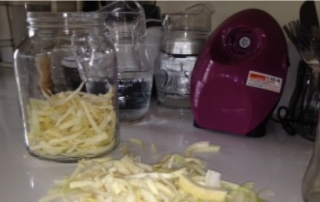Salt Free Sauerkraut
By Mary Minihane
Fermentation is the process of breaking down or predigesting food to make it more easily digestible. It can also improve the flavor, texture, appearance and smell, synthesise vitamins (including B-12, which is difficult to get in vegetarian diets), reduce or eliminate flatulence, increase storage life, and add to your intestinal micro-flora or gut bacteria. Fermented foods have a long history in many cultures, with sauerkraut being one of the most well-known in the Western World. It is believed to have been introduced to Europe by Genghis Khan.
I was a late convert to ferments and have really only began to eat them in the past year. I find that sauerkraut is the easiest to make and the most pleasant to eat. I have purchased a jar of pre-prepared stuff only once and found it tough to chew but the main reason for me preparing my own is the fact that I have totally eliminated salt from my diet and all commercially prepared product is prepared using salt. I prepare mine using celery juice.
Clean everything: When fermenting anything, it’s best to give the good, beneficial bacteria every chance of succeeding by starting off with as clean an environment as possible.
I use 2 small heads of organic white cabbage and 2 heads of organic celery. I save the outer leaves and finely cut the remainder of the cabbage and place some of it fairly loosely in the jar, filling to the top. I find that if I pack it too tightly in the beginning the juice may not penetrate to the bottom. I then add some juice and pack it tightly. I continue to add cabbage and juice until the jar is as tightly filled as possible. I place the saved leaves at the top and close it tightly. Leave on the counter to ferment. If there is space at the top of the jar I would put in a ramekin in order to put pressure on the product and ensure that it remains submerged in the juice.
The minimum fermentation time is about three days, though it will continue to ferment and become tastier for many days after that. Lift the lid at least twice per day to let any gas build up escape and after 2 days taste it. You may see bubbles, foam, or white scum on the surface but these are all signs of normal, healthy fermentation. The white scum can be skimmed off as you see it or before refrigerating it. The juice can sometimes bubble up over the top of the jar. It’s nothing to worry about. Just put a plate under the jar to catch the drips and make sure the cabbage is always covered by the juice.
Keep tasting it and refrigerate when it tastes good to you. It is safe to eat at every stage of the process, so there is no real minimum or maximum fermentation time. Your sauerkraut will keep for many months but as you remove some from the jar you should continue to ensure that the remainder is covered by juice.

